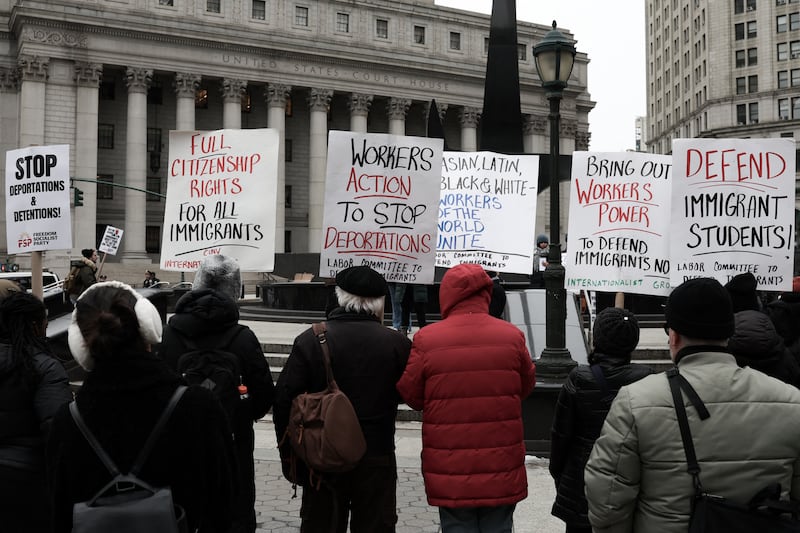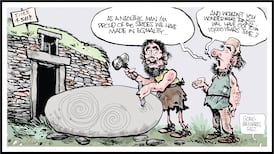“It’s a beautiful thing boys,” declared one man with a thick Dublin accent as the line of demonstrators lugging “Coolock Says No” placards and waving Union Jacks tramped past a line of pink Translink buses. Two of the marchers embraced, one holding a Tricolour, the other an Ulster banner. In a couple of hours this “beautiful thing” would be unleashed upon the city, orange and green uniting to carry out what can only be described as violent anti-immigrant persecution.
A marriage of convenience between elements of the Republic’s nativist movement and Ulster loyalists is like a United Ireland wished on a cursed monkey’s paw. Before long the anti-Islam demonstration sparked by the brutal murder of three young girls in England (by a non-Muslim) turned into violent rioting. Counter demonstrators were assaulted and hospitalised as the mob tore through Belfast, the PSNI seemingly unable to stop small groups of rioters.
By morning, mainly immigrant businesses stood charred and looted, the footpaths were littered with shattered glass and the debris of livelihoods was lost to a hurricane of hate. As communities in Belfast come together to try to pick up the pieces, Ireland must reckon with its national flag being used as a symbol of racism.
Earlier this year Taoiseach Simon Harris made a speech where he said it was time to “take our flag back”, but I’m not sure he meant it in the way that we need it to be done. For Ireland’s young people his battle is in the past, their fight for the flag will be with the far right. As the tension around immigration becomes more toxic and violent, many young Irish people are saying the flag makes them uncomfortable; the thing is that once you surrender your flag to the racists, it’s very hard to get it back. Even if you want to.
First group of migrants deported from US arrive in Costa Rica
Asylum system overhaul: What is changing beyond all the talk of reform?
Deportation orders triple as Ireland enforces a ‘firmer approach to migration’
Ireland can’t use housing shortfalls as excuse for failing to accommodate single male asylum seekers, ECJ says
The St George’s cross in England is a prime example of this, with a YouGov survey showing that 27 per cent of young people in the UK see the flag in a negative light. This aversion is more or less entirely down to its heavy usage by the far right. The flag became synonymous with the violent English nationalist movement of the 1980s and the groups it spawned such as the National Front, Combat 18 or more recently the EDL. This movement was distinctly anti-Irish and fostered close ties with Ulster loyalism, even rearing its ugly head in Dublin during the Lansdowne Road riots in 1995.
More recently, this flag has been front and centre in the orgy of unrest across the UK, tied around the neck of a man in Middlesbrough stopping to ask motorists whether they were white before letting them pass, or held high by protesters as they stormed a Holiday Inn housing asylum seekers. As Ireland’s far right fall inexorably into the orbit of their English counterparts, we can expect to see horrific acts perpetrated before our flag as well.
Ireland is unique in western Europe in that for the longest time there was inherent anti-colonialism in its nationalism. While many of the nationalisms of our neighbours can only look back, Irish nationalism can look forward. Having a nationalism where progressive values and national pride are not mutually exclusive means young people in Ireland are free to have pride in their country without a supremacist undercurrent.
The miasma of the Troubles and the stifling grip of the Catholic Church have diminished. Londoners are downing Guinness at a rate of knots, Irish celebrities frequently feature in Hollywood hits, BBC 2 is playing the hurling and a car bomb is a drink. Our traditional music is still booming from stages through groups such as Lankum, our language is being championed by groups such as Kneecap and brands such as Pellador celebrate Irishness through fashion. Ireland’s youth bask in their identity.
Culture, like people, evolves. But the far right need identity to be frozen in time, a flag for a dead country, freeze-dried patriotism that can be reheated before election time to invoke nostalgia for a past we are actually pretty ashamed of. Our flag shouldn’t be handed over so easily, it should be defended as a symbol of hope and freedom from the long night of ignorance and oppression.
People in Dundalk, including traditional music act The Mary Wallopers, stood their ground last month, gathering to disrupt an anti-immigration rally. On the other side a woman wailed into a microphone in a tirade that stank of English-style nationalism.
“This is what it’s all about, the flag of this country, and its only ever going to be about this flag, and if you don’t like it, get on the bus, get on the plane and get on the boat you got off.”
This style of rhetoric that was once anathema to Irishness is being given a green paintjob by online grifters such as Tommy Robinson. As the battle for ownership of a national story intensifies, positions can be lost or gained, occupied or retreated from. If the far right are after the flag, you take the flag; if they’re going to organise, you organise; don’t leave holes in your defence.
Having a national identity is important, there’s nothing wrong with being proud of where you’re from. Having our own sports, music and language is intrinsic to how we orient ourselves in the world. The nightmare situation is one where that pride becomes conflated with racism, one where venerating our shared heritage becomes taboo for fear of appearing ignorant.
This means it is more important than ever to celebrate the struggle for independence and equality that took place on this island and make sure the invasive weed of English-style nationalism can’t grow over our songs, stories and symbols. Our job is to keep our heritage safe, for the next generation and the ones after that.
Adam Doyle is an artist and film-maker who goes under the name Spicebag
- Listen to our Inside Politics Podcast for the latest analysis and chat
- Sign up for push alerts and have the best news, analysis and comment delivered directly to your phone
- Find The Irish Times on WhatsApp and stay up to date











